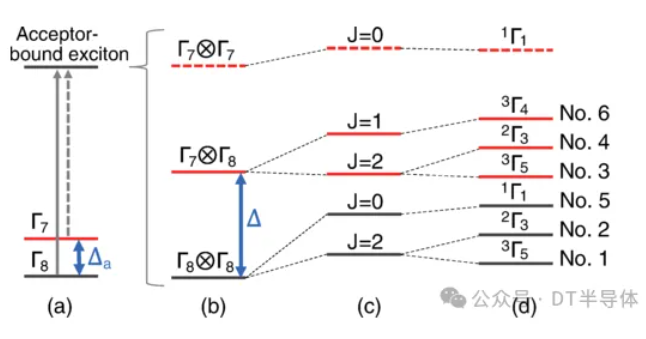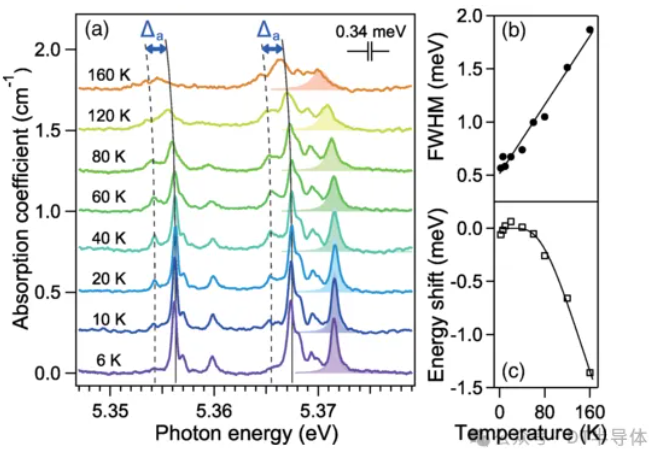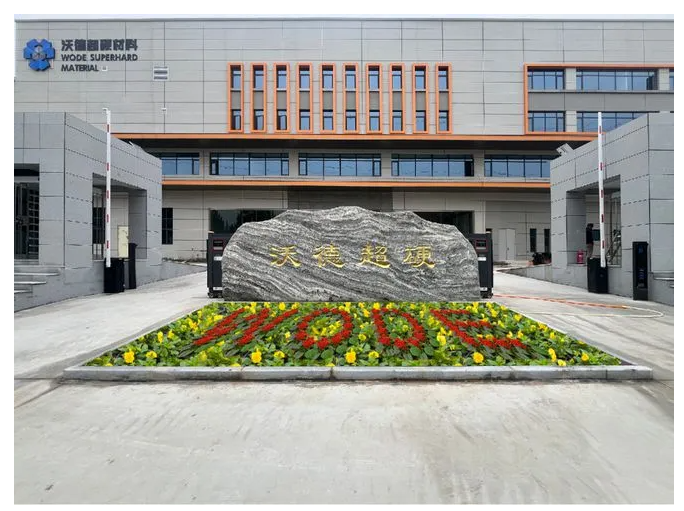钻石以其闪耀的光芒和珍贵的地位闻名于世,但其在工业和科学领域的应用潜力同样令人瞩目。传统上,钻石因其无与伦比的硬度和导热性,被广泛应用于切割工具、钻探设备以及热管理系统中。然而,钻石的独特性质远不止于此。近年来,科学家们开始深入探索钻石在电子学和量子技术中的应用,发现钻石在这些领域中具有独特的优势。
钻石因其极高的硬度和优异的导热性,早已在切割工具和热管理设备中得到广泛应用。然而,近年来,科学家们开始探索其在电子学中的潜力。高纯度的合成钻石在掺杂特定元素后可以成为出色的半导体材料,这为未来的电子器件开辟了新的可能性。例如,掺杂硼的钻石可以用作超高频的电子器件、量子计算中的量子比特以及高效的紫外发光二极管。
掺杂是指在材料中引入少量的其他元素,以改变其电子性质。在半导体中,掺杂元素可以作为电子供体或受体,从而调节材料的导电性。这些掺杂引入的额外电子或空穴(电子缺失的位置)不会参与原子的键合,但可能会与激子结合。激子是由一个电子和一个电子空穴组成的准粒子,掺杂可以引发复杂的物理变化。在掺杂硼的钻石中,激子复合体的结构一直存在争议。激子复合体是由两个带正电的空穴和一个带负电的电子组成的束缚态。科学家们提出了两种不同的解释,而这些解释的关键在于如何准确测量激子的结构。
突破性的激子研究
近日,由京都大学领导的国际研究团队最近在这一领域取得了重大突破。他们通过光吸收技术直接观察到了掺杂硼的蓝色钻石中受主束缚激子的精细结构。这一研究突破了传统发光测量的能量分辨率极限,使得研究人员能够更准确地测量激子的精细结构。
团队通过将钻石冷却到低温,使用深紫外吸收光谱获得了九个峰值,相比传统发光测量方法通常只能获得四个峰值。研究人员还开发了包括自旋-轨道效应的分析模型,以预测能量位置和吸收强度。这一发现证实了激子复合体中两个正电空穴比电子-空穴对更强的束缚作用。

图一: (a) Four-body diagram of an acceptor-bound exciton, (b) conventional model describing an acceptor-bound exciton, considering onlyΓ8 acceptor holes, and (c) our model introducing the split-off holes of Γ7 symmetry.

图二:(a) Schematic of absorption transitions from acceptor (Γ8, Γ7) to acceptor-bound exciton states. (b) Two-hole states extended for split-off (Γ7) holes, including (c) hole-hole exchange interaction and (d) crystal-field splitting. Δa and Δ denote the spin-orbit splitting in the acceptor and bound exciton states, respectively. The split levels are shown not to scale and grouped in (d) by the triplet system, rather than energy ordering (numbers 1–6) in the measured spectra.

图三:(a) Absorption spectra of bound excitons in boron-doped diamond between 6 and 160 K. The dashed lines represent transitions from the upper acceptor level. (b) Temperature dependence of the Lorentzian width (FWHM) of line number 6 [shaded in (a)]. (c) Temperature shift of line number 6. The solid lines in (b) and (c) represent fit functions

图五:(a) Higher-resolution absorption spectrum at 2 K (thick black line) fitted with the sum (dotted red line) of 11 Voigt functions, numbers 1′–6 (thin lines). The labels near the respective peaks represent the symmetry of the two-hole states. The brackets and horizontal bars at the top indicate two sets of triplets and the approximate size of the splittings, respectively. (b) Comparison of the experimental and theoretical absorption strengths. Orange bars with dots indicate the areal intensities of numbers 1, 2, and 4 superposed on top of numbers 1′, 2′, and 4′, respectively. Thinner bars indicate intensities of primed peaks. The theory (gray bars) includes the electron-hole exchange effect for numbers 1′−2 and valley-orbit splitting for numbers 5′ and 5 (details in Sec. III of the Supplemental Materia
研究团队表示,未来他们将探索在外部电场下进行吸收测量的可能性,这将导致进一步的谱线分裂并验证由于对称性变化引起的变化。这种研究方法有望揭示更多关于激子和自旋-轨道相互作用的细节,从而为开发更高性能的电子器件提供理论基础。
这一研究不仅对固态材料有重要意义,还为其他系统(如原子和核物理)中的自旋-轨道相互作用提供了有价值的见解。对材料的深入理解将推动钻石器件的性能提升,如高效的发光二极管、量子发射器和高灵敏度的辐射探测器等。
注:以上部分数据信息来源于“Spin-Orbit Effects on Exciton Complexes in Diamond” by Shinya Takahashi, Yoshiki Kubo, Kazuki Konishi, Riadh Issaoui, Julien Barjon and Nobuko Naka, 26 February 2024, Physical Review Letters.
说明:本文部分素材来自网络公开信息,由作者重新编写,转载请备注来源,本平台发布仅为了传达一种不同观点,不代表对该观点赞同或支持。


 手机资讯
手机资讯 官方微信
官方微信










 豫公网安备41019702003646号
豫公网安备41019702003646号